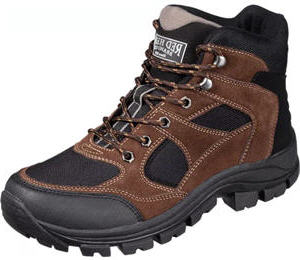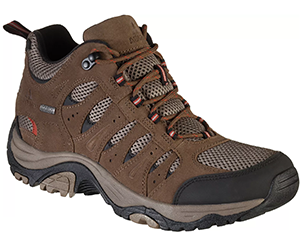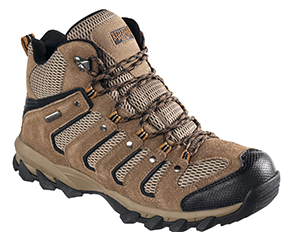
Hiking boots have come a long way since the 1980s when athletic-shoe-style hiking boots were first introduced. We’re also now wearing them for a more versatile array of outdoor adventures from fastpacking and trail running, to extended backcountry hunting treks and serious mountain trailblazing.

Mastering this broad shoe selection doesn’t have to be overwhelming - finding your perfect hiking boots is an easy matter of understanding the anatomy of hiking boots and some specialty features, the different types of boots available, and knowing when to replace them.
Tip: Beginner's Guide to Safe Hiking Tips & th Best Gear
Shop hiking boots for men, shop hiking boots for women, shop base layers for kids at Bass Pro Shops.
Shop hiking boots for men, shop hiking boots for women, shop base layers for kids at Cabela's
How are Hiking Boots Made
Boot Uppers - Made of leather, fabric and rubber, these portions cover your feet from the soles up and are attached to the lasts with a combination of adhesive and stitching. The type of material used to construct the uppers impacts their weight, breathability, warmth factor, durability and water-protection level. Most leather uppers are waterproof, and nearly all are extremely supportive and durable, which makes leather a top choice for uppers. Uppers constructed from a single piece of material will have great water resistance, too.
- Full-grain leather - Taken from the cowhide’s exterior.
- Suede - Flexible and breathable, but not as supportive and definitely not waterproof.
- Reverse full-grain leather - Full-grain leather turned inside out for a rough texture.
- Nubuck - Brushed to remove or hide irregularities.
- Mesh - Used in combination with leather for breathability.
- Synthetics - Polyester, nylon and man-made leathers. Lighter than leather and quick drying, boots made from these have a quicker breaking-in period. May wear out sooner than leather boots.

Audit
Other components of the boot uppers - Every piece plays an important role, and understanding these will help you choose the right boots.
- Toe boxes - Also called rands, these act as bumpers to surround and protect your toes. These are made of rubber or plastic material, and also provide waterproof seals between the soles and uppers.
- Collars - Sit atop the uppers, and help stabilize and cushion the ankles and Achilles tendons as well as prevent debris from getting into your boots.
- Heel cups - Also called heel counters, these cradle and support the heels, minimizing the chances of your shoes lifting off your ankles when you walk, thereby helping prevent blisters. They also offer lower-ankle stability.
- Liners - Sometimes built into the uppers to increase water repellency and aid in warmth retention in colder temperatures. Most beneficial for fabric uppers.
Soles - Hiking boots’ soles have three components: insoles, midsoles and outsoles. The soles are attached to the uppers with either stitching or adhesive. While stitched soles are easier to replace, glued or cemented soles are lighter and more flexible.
Insoles - Often removable, these directly touch and cushion your feet.
Midsoles - Provide stability and disperse weight. Incorporated shanks made of plastic or steel provide stiffness and even more support to the bottom of the boots.
Compression-molded EVA - A foamlike material, ethyl vinyl acetate is extremely lightweight.
Injection-molded EVA - Hot plastics are injected into a mold for more uniform density from heel to toe. Lightweight without the need for stitching, these midsoles are more waterproof than soles with stitching because there are fewer seams.
PU - Short for polyurethane, this is relatively heavier but offers durable support with greater impact resistance and shock absorption
TPR - Short for thermoplastic rubber, this material is flexible like leather, but lighter, washable and more durable.

Outsoles - Made of rubber and sometimes hardened with carbon for durability, these are what help keep you on your feet. Most have lugs on the bottoms - protruding rubber tips that provide traction and help shed mud. Lugs vary in size according to the type of shoes they’re on. Note that extra-hardened outsoles can feel slippery if you go off trail.
Hiking Boot Technologies Pros & Cons
Knowing the pros and cons and necessity of different weatherproofing technologies that are out there for footwear will help ensure you have the right boots for the job without spending too much or buying something you don’t need.
Water-resistant vs. Waterproof - Water-resistant fabrics and treatments shed water but don’t prevent water from soaking through to your feet once your boots are saturated. Waterproof liners and laminates applied to seals and uppers 100% block water from soaking through to your feet.

Breathability - Make sure that if your boots are waterproof, they’re also breathable. Most high-quality waterproof treatments make the fabric weave smaller than a water molecule, but large enough for air to escape through. This helps keep your feet drier and therefore warmer in cold weather.
Understanding the Hiking Boot Types & Function
Light/Active Hiking Boots - These beefed-up running shoes are designed for one- to two-day hikes that involve carrying a light load when you feel the call to tread off the beaten path.
Usually lightweight and flexible with limited ankle support due to lower cuts, these feature combination uppers of leather and mesh for overall support and breathability, sometimes at the cost of little to no water protection. Conservative tread and lugs make these best for maintained trails, and these usually have a short breaking-in period.
Midweight/Traditional Hiking Boots - The most versatile of hiking-boot options, these are designed for walking over varying terrain with moderate inclines, and can support your feet, arches and ankles with enough cushion and comfort for carrying midweight to heavy packs. Uppers are usually a combination of leather and synthetics, giving them abrasion resistance and water protection.

Hiking Boots for Men - great for
lightweight hiking & backpacking
Midsoles are stiffer with durable, lightweight outsoles that are sturdy enough to withstand aggressive mileage. These are offered in different cuts &#— low, mid and high heights — making them ideal not only for hiking but trail running, fastpacking and training.
Backpacking/Mountain Boots - Designed for multiple days on the trail or deep backcountry trips with extreme terrain and the most relentless weather, these support you the best when you’re carrying a heavy pack. Designed so you can tackle the harshest Mother Nature offers, these are as stout as they get - durable, supportive, waterproof, breathable and warm.
Their high-shaft leather uppers provide maximum ankle support, and have stiff midsoles to protect your feet from rocky terrain. Deep, aggressive tread and longer lugs shed mud and debris better. These are also heavier, and can have longer break-in periods.
When to Replace Your Hiking Boots
Like any equipment, hiking boots are going to wear out; when they wear out depends on how long you’ve had them, how much you’ve worn them and what kind of weather they’ve been through. Knowing when they’re shot is key to ensuring a positive outdoor experience as well as having healthy feet to carry you through to your next excursion. Replace your boots if:
- The soles are worn smooth (lugs are gone) and no longer provide adequate traction.
- If water begins to seep in - a sign the waterproof treatment has been compromised or the seams are unsealing.
- If you get blisters in places you didn’t used to before.
- If the linings become worn with visible wear holes.

Waterproofing
Aerosol
Tip: Shop Insoles, Boot Dryers & Shoe Accessories here
Other Boot & Footwear Accessories for the Hiker
To ensure a long life for your boots and a comfortable experience for your feet, make sure you’re wearing adequate socks that will help your boots perform their best. Stay away from 100% cotton hiking socks, as these retain moisture instead of wicking it away from your skin - wearing these on a longer hike are usually just asking for blisters.
Your laces may wear out before your boots, and replacing them if they are fraying or breaking is an affordable way to keep wearing your boots. If your light or midweight boots did not come with a water-protection technology, sprayable water-resistant treatments like Cabela's Waterproofing Aersol are available that you can apply yourself.
- 5446 views

